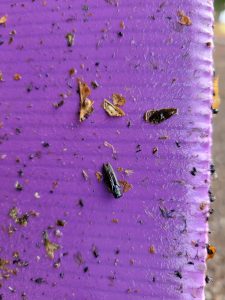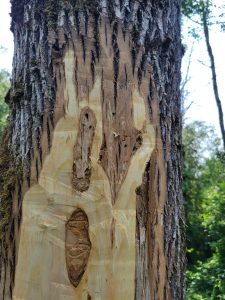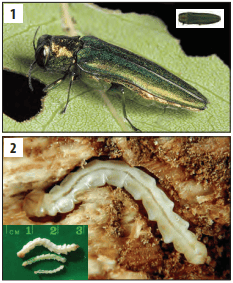SALEM, Ore. – The invasive emerald ash borer (EAB) pest has been discovered in three new Oregon counties this summer, according to the Oregon Dept. of Agriculture (ODA) and Oregon Dept. of Forestry (ODF). The U.S. Dept. of Agriculture (USDA) Animal Plant Health Inspection Service (APHIS) laboratory in Maryland has officially confirmed the insect in Marion and Yamhill counties. A third site on the border of Clackamas and Marion is believed to harbor EAB. Still, state officials first need to confirm with the federal lab the identity of the insects found there.
Yamhill County
One adult beetle was found in a trap in the Gaston area – one of 197 traps distributed by ODF and USDA APHIS in the Willamette Valley. The federal lab officially confirmed the find as EAB on Aug. 12. The trap was located just inside Yamhill County about seven miles from Forest Grove, where EAB was first detected in Oregon in late June 2022.
Clackamas County
Jake Downer, a contract worker with Portland General Electric, reported to the state seeing ash trees in the Elliot Prairie area east of Woodburn showing canopy decline in mid-July, not long after he and other utility workers had received training from the Oregon Dept. of Agriculture in how to identify EAB infestations. The site is inside Clackamas County, not far from the border with Marion County.
ODF’s Invasive Species Specialist, Wyatt Williams, visited the site in early August. He saw evidence that EAB larvae had been feeding on Oregon ash trees (Fraxinus latifolia), with several trees showing a marked decline. Samples have been sent to the federal lab in the eastern U.S. for official confirmation.
Williams also looked at several ash trees in a steep, blackberry-choked site along Butte Creek north of Mt. Angel and south of Hubbard. The creek forms the border between Clackamas and Marion counties. He said the trees on both sides of the creek showed strong signs of EAB infestation, with declining canopies and D-shaped exit holes where adults have tunneled out of the tree trunks.
“The extent of dieback suggests that EAB may have been present for a number of years at the site but went unnoticed given the difficult access and dense vegetation, which includes a mix of oak and conifers,” said Williams.
Marion County
 On July 30, Williams found adult EAB in traps set along the Pudding River south of Woodburn and west of Mt. Angel. He retrieved five adults from a trap at that site, indicating a significant population. Samples from that site have also been confirmed as EAB by USDA APHIS’s lab.
On July 30, Williams found adult EAB in traps set along the Pudding River south of Woodburn and west of Mt. Angel. He retrieved five adults from a trap at that site, indicating a significant population. Samples from that site have also been confirmed as EAB by USDA APHIS’s lab.
“Given the trees did not show any signs of damage, we would not have known about this site for some time if not for the traps,” said Williams.
Cody Holthouse is Compliance and Regulatory Manager at ODA. He chairs the state’s Interagency EAB Task Force. “No state has been able to eradicate EAB, so since its first detection in Forest Grove, we have expected it to eventually show up in new parts of Oregon,” said Holthouse. “That’s why folks from collaborating agencies have been methodically surveying for the insect, setting out traps beyond the known infestation area and training people to know the signs and symptoms of infestation. That definitely helps us learn where the insect is spreading.”
Holthouse said ODA will be conducting intensive searches in the coming days for EAB in areas surrounding the new sites in Marion and Clackamas counties to find out whether it shows up farther away.

He said it is unknown if the newly discovered sites represent a spread from Forest Grove or if they were from separate introductions of the pest into Oregon. The pest often travels in loads of firewood transported by people, so the latter is quite possible.
Holthouse says ODA is currently working out the details of a quarantine to limit the movement of ash, olive, and white fringe tree wood, and other materials similar to the one in Washington County. That quarantine restricts the movement of several tree materials, including but not limited to logs, green lumber, nursery stock, scion wood, bud wood, chips, mulch, stumps, roots, branches, and firewood of hardwood species.
“We want to protect the rest of Oregon for as long as possible to give communities more time to prepare,” said Holthouse.
To slow further spread, Holthouse urges Oregonians to buy firewood near where they intend to burn it and avoid taking firewood more than 10 miles from where it was cut.
About EAB
A small, metallic-green beetle native to eastern Asia, EAB was first found in the U.S. in Michigan in 2002. It has since killed tens of millions of ash trees across the eastern United States, with death rates up to 99 percent.
EAB’s larvae burrow into the bark of ash trees, causing canopy dieback and, ultimately, tree death. The ½ inch beetle is often challenging to detect, especially in newly infested trees. Signs of infestation include thinning and yellowing leaves, bark splitting, D-shaped holes in the tree bark, and basal shoots.
For more information on EAB and an up-to-date list of resources, please visit ODA.direct/EAB
Suspected EAB infestations can be reported over the phone at 1-866-INVADER or online at https://oregoninvasiveshotline.org/reports/create
Here’s more details about the Emerald Ash Borer/EAB: OSUExtemeralashborerem9160
|


